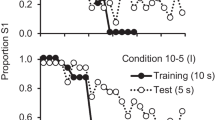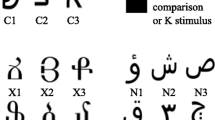Abstract
Experiment 1 has examined the effect of overtraining on shift learning in a simultaneous matching- (or nonmatching-) to-sample discrimination. Experiment 2 has examined how much overtraining is required for rats to form the concept of matching in a matchingto- sample discrimination. In Experiment 1, rats were overtrained on a simultaneous matching-to-sample discrimination or nonmatching-to-sample discrimination in a discrete threestimulus- presentation T-type jumping stand and were transferred to either a nonshifted (nonshift) or a shifted task (shift). Group Nonshift learned their subsequent shift task more rapidly than Group Shift, regardless of whether rats were tested on the matching-to-sample task or the nonmatching-to-sample one (symmetry of transfer effect). Experiment 2 shows that the apparent asymmetry of transfer effect is observed at reaching criterion (OT-O), whereas the symmetry of transfer effect is observed after 5 days, 10 days, 15 days, and 20 days of overtraining. These results indicate that overtraining is an obvious operational precondition for symmetry of transfer effect in matching- (or nonmatching-) to-sample discrimination in rats.
Similar content being viewed by others
References
AGGLETON, J. P. (1985). One-trial object recognition by rats. Quarterly Journal of Experimental Psychology, 37B, 279–294.
COOK, R. G., CAVOTO, K. K., & CAVOTO, B. R. (1995). Same-different texture discrimination and concept learning in pigeons. Journal of Experimental Psychology: Animal Behavior Processes, 21, 253–260.
COOK, R. G., CAVOTO, K. K., & CAVOTO, B. R. (1996). Mechanisms of multidimensional grouping, fusion, and search in avain texture discrimination. Animal Learning & Behavior, 24, 150–167.
COOK, R. G., KATZ, J. S., & CAVOTO, B. R. (1997). Pigeon same-different concept learning with multistimulus classes. Journal of Experimental Psychology: Animal Behavior Processes, 23, 417–433.
COOK, R. G., & WIXED, J.T. (1997). Same-different texture discrimination in pigeons: Testing competing models of discrimination and stimulus integration. Journal of Experimental Psychology: Animal Behavior Processes, 23, 401–416.
DELIUS, J. D., AMELING, M., LEA, S. E. G., & STADDON, J. E. R. (1995). Reinforcement concordance induces and maintains stimulus associations in pigeons. The Psychological Record, 45, 283–297.
DUBE, W. V., CALLAHAN, T. D., & MCILVANE, W. J. (1993). Serial reversals of concurrent auditory discriminations in rats. The Psychological Record, 43, 429–440.
EDWARDS, S. A., JAGIELO, J. A., ZENTALL, T. R., & HOGAN, D. E. (1982). Acquired equivalence and distinctiveness in matching-to-sample by pigeons: Mediation by reinforcer-specific expectancies. Journal of Experimental Psychology: Animal Behavior Processes, 8, 244–259.
FETTERMAN, J. G. (1991). Discrimination of temporal same-different relations by pigeons. In M. L. Commons, J. A. Nevin, & M. C. Davison (Eds.), Signal detection: Mechanisms, models, and applications (pp. 79–101). Hillsdale, NJ: Erlbaum.
HALL, G., RAY, E., & BONARDI, C. (1993). Acquired equivalence between cues trained with a common antecedent. Journal of Experimental Psychology: Animal Behavior Processes, 19, 391–399.
LAWRENCE, D. H. (1949). Acquired distinctiveness of cues: I. Transfer between discriminations on the basis of familiarity with the stimulus. Journal of Experimental Psychology, 39, 770–784.
LAWRENCE, D. H. (1950). Acquired distinctiveness of cues: II. Selective association in a constant stimulus situation. Journal of Experimental Psychology, 40, 175–188.
MACKINTOSH, N. J. (1965). Selective attention in animal discrimination learning. Psychological Bulletin, 64, 124–150.
NAKAGAWA, E. (1978). The effect of overtraining on discrimination learning in white rats (in Japanese). Japanese Journal of Psychology, 49, 70–77.
NAKAGAWA, E. (1986). Overtraining, extinction and shift learning in a concurrent discrimination in rats. Quarterly Journal of Experimental Psychology, 38B, 313–326.
NAKAGAWA, E. (1992a). Transfer of a matching and nonmatching concept in rats. Psychobiology, 20, 311–314.
NAKAGAWA, E. (1992b). Effects of overtraining reversal learning by rats in concurrent and single discriminations. Quarterly Journal of Experimental Psychology 44B, 37–56.
NAKAGAWA, E. (1992c). Transfer of matching and nonmatching learning in kindergarten children (in Japanese). Japanese Journal of Educational Psychology, 40, 266–275.
NAKAGAWA, E. (1993a). Matching and nonmatching concept learning in rats. Psychobiology, 21, 142–150.
NAKAGAWA, E. (1993b). Relational rule learning in the rat. Psychobiology, 21, 293–298.
NAKAGAWA, E. (1998). Stimulus classes formation in concurrent discriminations in rats as a function of overtraining. The Psychological Record, 48, 537–552.
NAKAGAWA, E. (1999a). A factor affecting stimulus classes formation in concurrent discriminations in rats. The Psychological Record, 49, 117–136.
NAKAGAWA, E. (1999b). Acquired equivalence of discriminative stimuli following two concurrent discrimination learning tasks as a function of overtraining in rats. The Psychological Record, 49, 327–348.
NAKAGAWA, E. (1999c). Mechanism of stimulus classes formation in concurrent discriminations in rats. The Psychological Record, 49, 349–368.
NAKAGAWA, E. (1999d). Transfer of learning between concurrent discriminations and matching (or non-matching)-to-sample discrimination in rats. Quarterly Journal of Experimental Psychology, 52B, 125–143.
NAKAGAWA, E. (2000a). Reversal learning in conditional discrimination is not controlled by reinforcement density. The Psychological Record, 50, 117–140.
NAKAGAWA, E. (2000b). Effects of overtraining on reversal and nonreversal in concurrent discriminations in rats. The Psychological Record, 50, 557–576.
NAKAGAWA, E. (2000c). Transfer of learning between matching (or nonmatching)-to-samp!e and same-different discriminations in rats. The Psychological Record, 50, 771–805.
NAKAGAWA, E. (2001a). Cross-modal stimulus class formation in rats. The Psychological Record, 51, 53–66.
NAKAGAWA, E. (2001b). Acquired equivalence of cues in learning a matching-to-sample task by rats. The Psychological Record, 51, 453–472.
NAKAGAWA, E. (2001c). Effects of overtraining on shift learning in matching- (or nonmatching)-to-sample discrimination in rats. The Psychological Record, 51, 473–494.
SANTIAGO, H., & WRIGHT, A. A. (1984). Pigeons memory: Same/different concept learning, serial probe recognition, and probe delay effects on the serial-position function. Journal of Experimental Psychology: Animal Behavior Processes, 10, 498–512.
URCUIOLI, R. J. (1977). Transfer of oddity-from-sample performance in pigeons. Journal of the Experimental Analysis of Behavior, 27, 195–202.
URCUIOLI, P. J., & NEVIN, J. A. (1975). Transfer of hue matching in pigeons. Journal of the Experimental Analysis of Behavior, 24, 149–155.
URCUIOLI, P. J., ZENTALL, T. R., JACKSON-SMITH, P., & STEIRN, J. N. (1989). Evidence for common coding in many-to-one matching: Retention, intertriai interference, and transfer. Journal of Experimental Psychology: Animal Behavior Processes, 15, 264–273.
VAUGHAN, W., Jr. (1988). Formation of equivalence sets in pigeons. Journal of Experimental Psychology: Animal Behavior Processes, 14, 36–42.
WASSERMAN, E. A., HUGART, J. A., & KIRKPATRICK-STEGER, K. (1995). Pigeons show same-different conceptualization after training with complex visual stimuli. Journal of Experimental Psychology: Animal Behavior Processes, 21, 248–252.
WILSON, B., MACKINTOSH, N. J., & BOAKES, R. A. (1985). Matching and oddity learning in the pigeon: Transfer effects and the absence of relational learning. Quarterly Journal of Experimental Psychology, 37B, 295–311.
WRIGHT, A. A. (1991). Concept learning by monkeys and pigeons. In W. A. Abraham, M., Corballis, & K. G. White (Eds.), Memory mechanisms: A tribute to G. V. Goddard (pp. 241–272). Hillsdale, NJ: Erlbaum.
WRIGHT, A. A., SANTIAGO, H. C., & SANDS, S. F. (1984). Monkey memory: Same/different concept learning, serial probe acquisition, and probe delay effects. Journal of Experimental Psychology: Animal Behavior Processes, 10, 513–529.
WRIGHT, A. A., SANTIAGO, H. C., SANDS, S. R., KENDRICK, D. E., & COOK, R. G. (1985). Memory processing of serial list by pigeons, monkey, and people. Science, 229, 287–289.
WRIGHT, A. A., SANTIAGO, H. O., URCUIOLI, P. J., & SANDS, S. F. (1983). Memory and pigeon acquisition of same/different concept using pictorial stimuli. In M. L. Commons, R. J., Herrnstein, & A. R. Wagner (Eds.), Quantitative analysis of behavior (Vol. 4, pp. 295–317). Cambridge, MA: Ballinger.
YOUNG, M. E., & WASSERMAN, E. A. (1997). Entropy detection by pigeons: Response to mixed visual displays after same-different discrimination training. Journal of Experimental Psychology: Animal Behavior Processes, 23, 157–170.
YOUNG, M. E., WASSERMAN, E. A., & GARNER, K. L. (1997). Effects of number of items on the pigeon’s discrimination of same from different visual displays. Journal of Experimental Psychology: Animal Behavior Processes, 23, 491–501.
ZENTALL, T. R., & HOGAN, D. E. (1974). Abstract concept learning in the pigeon. Journal of Experimental Psychology, 102, 393–398.
ZENTALL, T. R., & HOGAN, D. E. (1975). Concept learning in the pigeon: Transfer to new matching and nonmatching stimuli. American Journal of Psychology, 88, 233–244.
ZENTALL, T. R., & HOGAN, D. E. (1976). Pigeons can learn identity or difference. Science, 191, 408–409.
ZENTALL. T R., SHERBURNE, L. M., STEIRN, J. N., RANDALL, C. K., ROPER, K. L., & URCUIOLI, P. J. (1992). Common coding in pigeons: Partial versus total reversals of one-to-many conditional discriminations. Animal Learning & Behavior, 20, 373–381.
ZENTALL, T. R., STEIRN, J. N., SHERBURNE, L. M., & URCUIOLI, P. J. (1991). Common coding in pigeons assessed through partial versus total reversals of many-to-one conditional and simple discrimination. Journal of Experimental Psychology: Animal Behavior Processes, 17, 194–201.
Author information
Authors and Affiliations
Corresponding author
Rights and permissions
About this article
Cite this article
Nakagawa, E. Shift Learning in Matching-to-Sample Discriminations in Rats as a Function of Overtraining. Psychol Rec 52, 107–126 (2002). https://doi.org/10.1007/BF03395418
Published:
Issue Date:
DOI: https://doi.org/10.1007/BF03395418




